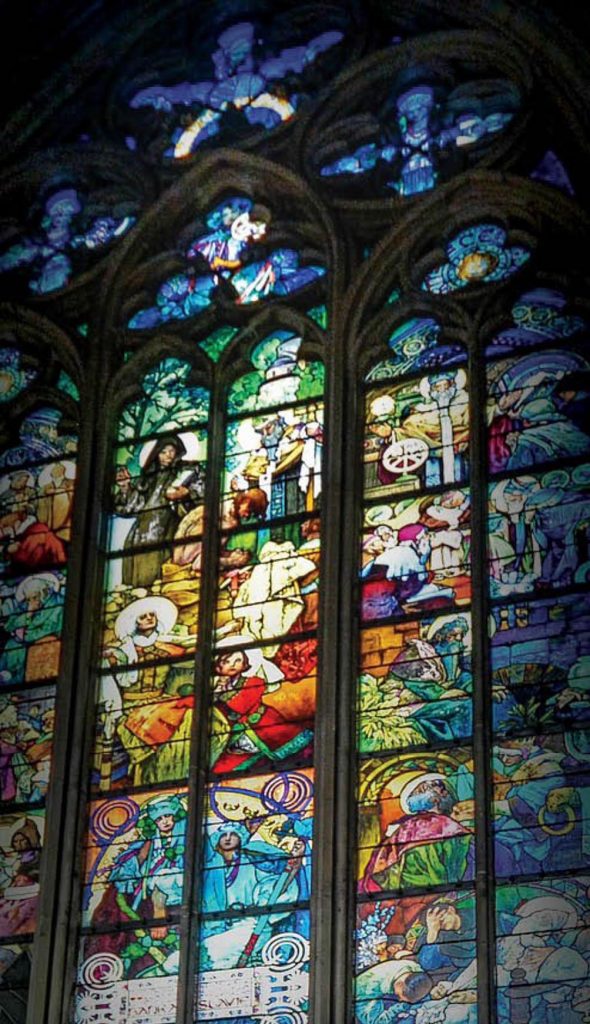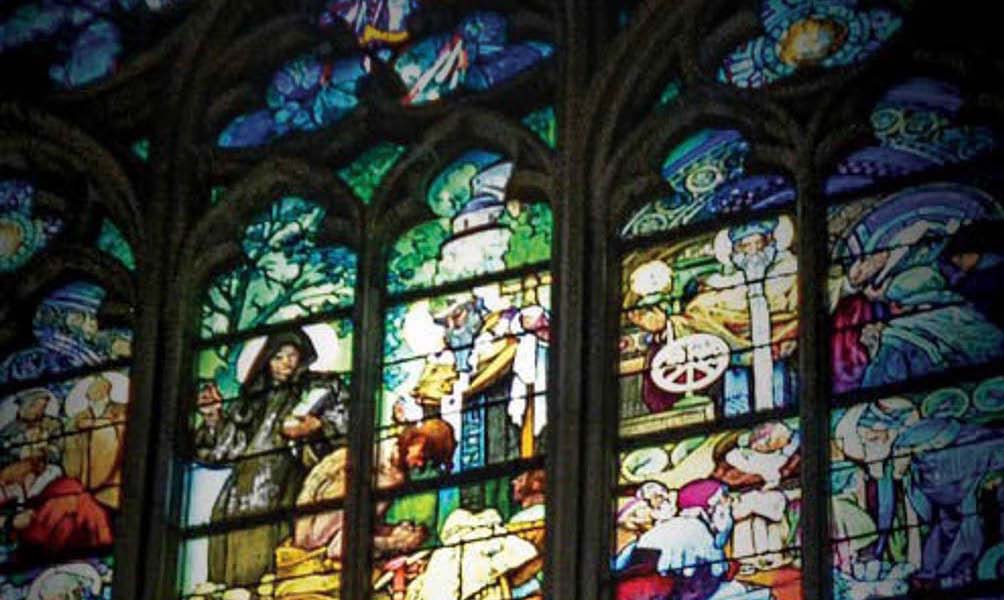
The Sacred Glass
Klōke’s ‘Aha!’ Moment
Art theft and pillaging occurred on a massive scale during World War II [i] and the recovery process continues to this day. Ironically, the largest forms of art were not stolen — the result of an ingenious ‘trick’ clever priests played on the Nazis.
How do you hide a cathedral stained-glass window that is thirty feet tall? Everyone knew that the Nazis would remove the glass, so the priests did it for them; but what they did next was brilliant. Rather than store the pieces in one place, they gave each piece to a different individual from the parish, telling each person to hide it and not tell anyone.
If the priests were asked where the art was, they replied — truthfully — they did not know. The frames were of no value without their contents. And if a piece of glass was found, for example, in someone’s bedroom drawer, there was no way of knowing what it was for or where it came from. This ‘trick’ validated Winston Churchill’s logic when he said [ironically, during World War II], “It is wonderful how well men can keep secrets they have not been told.” [ii] At the end of the war, the priests asked all the parishioners to return their pieces so the stained-glass artwork could be reconstructed.
Fast-forward to today, when historically unprecedented cyber-thievery redefines the concept of ‘pillage.’ The current cybersecurity ‘best practice’ is founded upon encryption, then stores the scrambled data — as a unit — back into the same file, where it can be easily found. Encryption is additionally problematic because it degrades over time, requires management of the encryption keys, and quantum computers will soon render encryption useless by nearly instantaneously crushing its ‘mathematical barriers,’ putting all digital assets protected with it at risk.
Klōke co-founder Doug Peckover recognized the ominous, universal threat of encryption’s inevitable failure. The genius of the priests inspired him to develop a Cybersecurity Solution founded upon their elegant logic — If you can’t find the ‘Treasure,’ you can’t steal the ‘Treasure’ – Defend the Data, Not a Location! The product of his effort is manifest in the Patent ‘Electronically Protecting Data and Digital Content’, issued as U.S. 7,937,579. [iii]
Simultaneously, the banking industry also recognized that more effective digital security was critically needed. Various Payment Card Industry (PCI) methods were researched, and a new one was selected to protect credit and debit transaction data. Seven months after U.S. 7,937,579 was filed, the industry announced a new standard they termed ‘Tokenization.’ This digital security upgrade is a notable success: since its implementation, there have been no reported security failures or data breaches of tokenized PCI data.
This ‘history lesson’ presents us with two interesting facts: (1) The security used to protect credit and debit transaction data can be traced back to how priests foiled the Nazis 80 years ago; and (2) Klōke’s co-founder was the first to invent Token Security.
Klōke’s mission is to make the well-proven ‘tokenization’ security method available for all types of data, in all types of applications and available to everyone.
| Lessons from Clever Priests | Now in Klōke |
|---|---|
| If someone found a hidden piece of glass, there was no record of where it came from | Klōke’s fragmented, dispersed data has no traceable owner and cannot be reverse engineered |
| A person could hide any type of glass | Klōke is device, application, network and data-type agnostic |
| The only way to re-assemble the art was for a priest to authenticate the request and then grant permission | The only way to ‘break’ Klōke’s security is by hacking authentication and then permission |
| Individuals or priests reported suspicious activities | Klōke’s threat intelligence reports unsuccessful access requests in real time |
| Over time, priests and parishioners got smarter about hiding glass | Klōke’s authentication gets smarter over time, without application changes |
| Priests shared what they learned with other churches | Klōke’s threat intelligence can provide other systems with real-time events |
A total of eight issued patents [with one additional pending patent application] expand Klōke’s original concept so that it includes:
- Threat intelligence
- ‘Agent-less’ control
- Business agility; and
- Ransom protection, including rapid recovery
U.S. 7,937,579 is recognized as unique and original work and has been cited [iv] widely by firms that include Microsoft, IBM, Verizon, Bank of America, Amazon, SAP, Sony and Lucent Alcatel.
One immutable truth is worth noting. All cybersecurity technologies other than tokenization will, someday, fail. Why? Because there are too many unfixable hardware and database flaws, infected IoT devices, infected data center components, infected PCs, infected plug-and-play devices, infected Android devices, infected Apple devices, infected browsers, infected Linux systems, infected network components, infected storage devices, infected Thunderbolt connections, infected Bluetooth connections, infected USB devices — even infected Zoom sessions — potentially exposing valuable personal, Enterprise and Government data to compromise and theft.
The way that Klōke solves this daunting problem can be traced back to those clever priests during World War II: If a piece of cathedral-window glass was discovered by the Nazis, there was no way for anyone to know where it came from. ‘Klōked’ data mirrors this ingenious security method. If a secure server is accessed and a hacker is able to re-create, say, the number ‘1403954,’ the number has no traceable owner. Is this an account number for an application? If so, which application? For which company? Or is it a dollar amount? Or a contract number? Or just random numeric ‘bits’ that happen to look like a ‘value.’ There is no way to know — so Klōked data remains secure, even if accessed without authority. Absolute control of the ‘Treasure’ is retained by its rightful owner.
Amen!
Download ‘The Sacred Glass’ White Paper [click here]
The Sacred Glass
Klōke’s ‘Aha!’ Moment
Art theft and pillaging occurred on a massive scale during World War II [i] and the recovery process continues to this day. Ironically, the largest forms of art were not stolen — the result of an ingenious ‘trick’ clever priests played on the Nazis.
How do you hide a cathedral stained-glass window that is thirty feet tall? Everyone knew that the Nazis would remove the glass, so the priests did it for them; but what they did next was brilliant. Rather than store the pieces in one place, they gave each piece to a different individual from the parish, telling each person to hide it and not tell anyone.

If the priests were asked where the art was, they replied — truthfully — they did not know. The frames were of no value without their contents. And if a piece of glass was found, for example, in someone’s bedroom drawer, there was no way of knowing what it was for or where it came from. This ‘trick’ validated Winston Churchill’s logic when he said [ironically, during World War II], “It is wonderful how well men can keep secrets they have not been told.” [ii] At the end of the war, the priests asked all the parishioners to return their pieces so the stained-glass artwork could be reconstructed.
Fast-forward to today, when historically unprecedented cyber-thievery redefines the concept of ‘pillage.’ The current cybersecurity ‘best practice’ is founded upon encryption, then stores the scrambled data — as a unit — back into the same file, where it can be easily found. Encryption is additionally problematic because it degrades over time, requires management of the encryption keys, and quantum computers will soon render encryption useless by nearly instantaneously crushing its ‘mathematical barriers,’ putting all digital assets protected with it at risk.
Klōke co-founder Doug Peckover recognized the ominous, universal threat of encryption’s inevitable failure. The genius of the priests inspired him to develop a Cybersecurity Solution founded upon their elegant logic — If you can’t find the ‘Treasure,’ you can’t steal the ‘Treasure’ – Defend the Data, Not a Location! The product of his effort is manifest in the Patent ‘Electronically Protecting Data and Digital Content’, issued as U.S. 7,937,579. [iii]
Simultaneously, the banking industry also recognized that more effective digital security was critically needed. Various Payment Card Industry (PCI) methods were researched, and a new one was selected to protect credit and debit transaction data. Seven months after U.S. 7,937,579 was filed, the industry announced a new standard they termed ‘Tokenization.’ This digital security upgrade is a notable success: since its implementation, there have been no reported security failures or data breaches of tokenized PCI data.
This ‘history lesson’ presents us with two interesting facts: (1) The security used to protect credit and debit transaction data can be traced back to how priests foiled the Nazis 80 years ago; and (2) Klōke’s co-founder was the first to invent Token Security.
| Lessons from Clever Priests | Now in Klōke |
|---|---|
| If someone found a hidden piece of glass, there was no record of where it came from | Klōke’s fragmented, dispersed data has no traceable owner and cannot be reverse engineered |
| A person could hide any type of glass | Klōke is device, application, network and data-type agnostic |
| The only way to re-assemble the art was for a priest to authenticate the request and then grant permission | The only way to ‘break’ Klōke’s security is by hacking authentication and then permission |
| Individuals or priests reported suspicious activities | Klōke’s threat intelligence reports unsuccessful access requests in real time |
| Over time, priests and parishioners got smarter about hiding glass | Klōke’s AI-driven authentication gets smarter over time, without application changes |
| Priests shared what they learned with other churches | Klōke’s threat intelligence can provide other AI systems with real-time events |
A total of eight issued patents [with one additional pending patent application] expand Klōke’s original concept so that it includes:
- Threat intelligence
- ‘Agent-less’ control
- Business agility; and
- Ransom protection, including rapid recovery
U.S. 7,937,579 is recognized as unique and original work and has been cited [iv] widely by firms that include Microsoft, IBM, Verizon, Bank of America, Amazon, SAP, Sony and Lucent Alcatel.
One immutable truth is worth noting. All cybersecurity technologies other than tokenization will, someday, fail. Why? Because there are too many unfixable hardware and database flaws, infected IoT devices, infected data center components, infected PCs, infected plug-and-play devices, infected Android devices, infected Apple devices, infected browsers, infected Linux systems, infected network components, infected storage devices, infected Thunderbolt connections, infected Bluetooth connections, infected USB devices — even infected Zoom sessions — potentially exposing valuable personal, Enterprise and Government data to compromise and theft.
The way that Klōke solves this daunting problem can be traced back to those clever priests during World War II: If a piece of cathedral-window glass was discovered by the Nazis, there was no way for anyone to know where it came from. ‘Klōked’ data mirrors this ingenious security method. If a secure server is accessed and a hacker is able to re-create, say, the number ‘1403954,’ the number has no traceable owner. Is this an account number for an application? If so, which application? For which company? Or is it a dollar amount? Or a contract number? Or just random numeric ‘bits’ that happen to look like a ‘value.’ There is no way to know — so Klōked data remains secure, even if accessed without authority. Absolute control of the ‘Treasure’ is retained by its rightful owner.
Amen!
Download ‘The Sacred Glass’ White Paper [click here]
Copyright © 2025 Klōke LLC | All rights reserved.
Copyright © 2022 Kloke LLC | All rights reserved.

